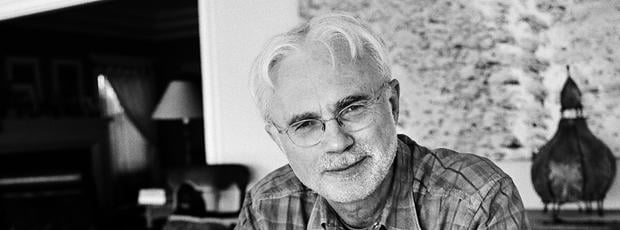The most performed living American composer, Adams builds on the rhythmic momentum of minimalism, but introduces sharp contrasts and a wide range of musical references.
Vital Statistics
Born:
February 15, 1947, Worcester, Mass.
Period:
20th-21st centuries
During Lifetime:
The postwar Baby Boom generation was born in the U.S. The atomic age begins with initial optimism about the peaceful atom but increasing worry about mutually assured destruction as the U.S. and Soviet Union build huge stockpiles of nuclear weapons.
Biographical Outline
Discovering Music, 1947-1965: Adams grows up in New England, where his father, a jazz clarinetist in bands, teaches his son the instrument. At about age 10, the boy decides to be a composer, and begins theory lessons. At age 14, he has a piece played by the local community orchestra.
College in the ’60s: At Harvard, where he earns a B.A. (1969) and an M.A. (1972), he studies with Leon Kirchner, principally, learning the styles of postwar modernism. He also plays clarinet occasionally with the Boston Symphony and absorbs the influence of the 1960s rock and pop revolution, as well as jazz and ethnic music.
San Francisco polyphony, 1972-1982: Adams is lured to the West Coast for its new ideas and opportunities for self-reinvention. He teaches at the San Francisco Conservatory of Music as head of the composition department and directs its New Music Ensemble.
Expanding horizons, 1978-1985: Looking for a way to make his music more sensuous and effective, Adams turns to minimalism, producing the classic Shaker Loops in 1978. He then serves as composer-in-residence of the San Francisco Symphony (1982-85), for which he composes his first major orchestral works, Harmonium (1981) and Harmonielehre (1985). With the demand for his works rising, Adams resigns from the Conservatory and takes up residence in Berkeley. Modern opera, 1985-1991: Approached by theater director Peter Sellars to write an opera, Adams teams with librettist Alice Goodman and Sellars to create Nixon in China (1987), which has a successful run at the Houston Grand Opera, and then at the Brooklyn Academy of Music. A second opera, The Death of Klinghoffer, with the same collaborators, premieres at the Theatre Royal de la Monnaie in Brussels in 1991.
Quickening the Tempo, 1991-2001: Adams produces a slew of works, including the Violin Concerto (1995), which wins the prestigious Grawemeyer Award for music composition; Century Rolls (1997), his piano concerto for Emmanuel Ax; the symphonies El Dorado (1991) and Naïve and Sentimental Music (1998); the Chamber Symphony (1992); John’s Book of Alleged Dances for the Kronos Quartet (1994); the theater piece I Was Looking at the Ceiling and Then I Saw the Sky, with poet June Jordan (1995); and the Nativity oratorio El Niño (2000). The composer steps up his conducting career and creates a number of arrangements and orchestrations of works by Liszt, Debussy, Astor Piazzolla, Charles Ives, and others.
Public works: On the Transmigration of Souls (2002), a “memory space” for chorus and orchestra, is given its premiere by the New York Philharmonic on the anniversary of the September 11 attacks, and wins the Pulitzer Prize. Now established as the most widely known and popular American composer of his generation, Adams works on a number of commissions, such as the operas Doctor Atomic for San Francisco Opera (2005) and A Flowering Tree for the New Crowned Hope Festival, Vienna (2006); the violin concerto Dharma at Big Sur (2003, for the opening of Walt Disney Hall in Los Angeles); and City Noir (2009, Los Angeles Philharmonic). Adams also curates a festival of his own works with Lincoln Center (2003), as well as both the Minimalist Jukebox Festival with the Los Angeles Philharmonic (2006) and West Coast/Left Coast (2009) as that orchestra’s Creative Chair.
Fun Facts
Inspired music: Harmonielehre was inspired by a dream of an oil tanker taking flight out of San Francisco Bay, and also by atonal composer Arnold Schoenberg’s book Harmonielehre (Theory of harmony). Chamber Symphony took inspiration from both Schoenberg and Ren & Stimpy cartoons.
Latin lover: Adams learned to speak Spanish to write El Niño and continues to read Spanish language books and media.
“A” is for ... : Although his boyhood playing days are behind him, Adams can occasionally be spotted at an Oakland A’s baseball game.
Married, With Children: Adams is married to photographer Deborah O’Grady and has two children, a daughter, Emily, and a son, Sam.
Recommended Biography
John Adams, Hallelujah Junction: Composing an American Life (Farrar Straus & Giroux, 2008).
The John Adams Reader: Essential Writings on an American Composer, edited by Thomas May (Amadeus Press, 2009).
Explore the Music
Adams is one of the preeminent contemporary composers of large orchestral works and operas. His music is usually founded on overlapping grooves called, generically, “ostinatos,” which grow and change through the piece. His music from the 1990s on brings in a larger measure of contrapuntal activity and varied scale forms and harmonies.
Early minimalism: Hearing Terry Riley’s In C in the early 1970s and Steve Reich’s and Philip Glass’ respective ensembles on tour inspired Adams and, like many listeners, he connected that music with “the emotional intensity of rock.” John Cage’s radical ideas were important to Adams early on, as was the jazz and orchestral music he had grown up with.
Romantic leanings: In his orchestral works, Adams looks back to composers such as Sibelius and Wagner for ideas on large-scale form and expressivity.
Embracing eclecticism: Adams creatively manages a wide variety of influences, from rock to late-Romantic music, even writing a piece on a thesaurus of musical scales (Slonimsky’s Earbox, 1996). In recent years he has composed music that explores a California sensibility, such as City Noir (2009) and The Dharma at Big Sur (2003).
Beyond classical: I Was Looking at the Ceiling ... (1995) uses rock and pop music. Hoodoo Zephyr and Light Over Water (1983) use electronic instruments, as does Doctor Atomic .
Recommended Websites
